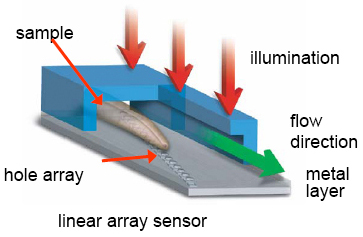Caltech unveils microsopic microscope
Last updated Jul 30, 2008 — 6071 views Caltech claims its researchers have “turned science fiction into reality” with their development of a single-chip “microscopic microscope.” Although it doesn’t have any lenses, the device is said to provide magnification comparable to that of sophisticated optical microscopes.
Caltech claims its researchers have “turned science fiction into reality” with their development of a single-chip “microscopic microscope.” Although it doesn’t have any lenses, the device is said to provide magnification comparable to that of sophisticated optical microscopes.
The microscope’s magnifying capabilities derive from a technology known as microfluidics, which is based on “the channeling of fluid flow at incredibly small scales,” according to the project. Applications for the so-called “optofluidic microscope” are expected to include field analysis of blood samples for malaria, or checking water supplies for giardia and other pathogens.

Caltech’s “optofluidic microscope” is about the size of a dime
“The whole thing is truly compact — it could be put in a cell phone — and it can use just sunlight for illumination, which makes it very appealing for Third-World applications,” notes Changhuei Yang, assistant professor of electrical engineering and bioengineering at Caltech and developer of the device. Yang says he expects it the chip to cost about $10 when it achieves mass production.
Yang thinks devices containing the microscope could even be implanted directly into the human body. Such a device, he suggests, could “autonomously screen for and isolate rogue cancer cells in blood circulation, thus, providing important diagnostic information and helping arrest the spread of cancer.”
“Our research is motivated by the fact that microscopes have been around since the 16th century, and yet their basic design has undergone very little change and has proven prohibitively expensive to miniaturize,” Yang explains. “Our new design operates on a different principle and allows us to do away with lenses and bulky optical elements.”
What makes it tick? Here’s the project’s description of what’s inside the microscope chips, and how they are fabricated:
“A layer of metal is coated onto a grid of charge-coupled device (CCD) sensor (the same sensors that are used in digital cameras). Then, a line of tiny holes, less than one-millionth of a meter in diameter, is punched into the metal, spaced five micrometers apart. Each hole corresponds to one pixel on the sensor array. A microfluidic channel, through which the liquid containing the sample to be analyzed will flow, is added on top of the metal and sensor array. The entire chip is illuminated from above; sunlight is sufficient.
Internal structure of the optofluidic microscope
When the sample is added, it flows — either by the simple force of gravity or drawn by an electric charge — horizontally across the line of holes in the metal. As cells or small organisms cross over the holes, one hole after another, the objects block the passage of light from above onto the sensor below. This produces a series of images, consisting of light and shadow, akin to the output of a pinhole camera.
Because the holes are slightly skewed, so that they create a diagonal line with respect to the direction of flow, the images overlap slightly. All of the images are then pieced together to create a surprisingly precise two-dimensional picture of the object.”
Chips containing hundreds — or even thousands — of optofluidic microscopes might one day be fabricated, according to Xiquan Cui, the project’s lead graduate student. This, he says, would make it possible to image and analyze numerous organisms simultaneously.
Discussions are in process with several biotech companies regarding mass-producing the devices, the University reports. The project was funded by DARPA’s Center for Optofluidic Integration at Caltech, the Wallace Coulter Foundation, the National Science Foundation, and the National Institutes of Health.
A short slide presentation about the device is currently available here (PDF file download).

[Photo and diagram courtesy of the Center for Optofluidic Integration.]


What I am wondering, is why someone sent a link to this page to me. I will admit that this is interesting. But there are a million interesting things out there. You know what I think? I think RSS is kind of a bad idea. Why? Well, RSS bombards a subscriber with endless tidbits. An article here, a funny message there… Its non-stop. That’s not so bad for the subscriber. But what about the instant message buddies of that subscriber… You see, because that subscriber is getting little tidbits all day long, he decides that he should share this with his IM buddies… I, someone who has never subscribed to an RSS feed, am one of those IM buddies. And so I get tons of quick IM messages… I open the IM, and there inside is a link… Being the knee-jerk internet junkie that I am, I click that link… Imagine putting some crack in front of a crack-head… Do you think the crack head would smoke the crack? I do… Well I click the link. I don’t even think about it… I just click that link…
As the browser opens and the page starts to load, I get that uneasy feeling of anticipation. And I like it. Then I start to take in what just loaded up… And low and behold. Its this…
Its an article about a microscopic microscope. Well, that is kind of cool. Because just look at the play on words there… It is, what it is designed to act upon… Imagine for a moment some other instance of this strange phenomenon… A drilled drill. A pealed pealer. Well, nevermind…
The point is, when I click that link in my IM window, I’m looking for a couple of things. First, is funny. I love the funnies. Second, is shock factor. And third is need-to-know… After that, it just turns into a big let-down. Kinda like when a crack-head smokes a big nugget of aspirin… He’s so happy while he’s suckin it down… But after a few seconds he realizes, “Hey! That wasn’t crack!!”.
A jeez, Nate, get a life! (get a clue?) This is an impressive invention. Small-scale, low-cost microscopy is exactly the kind of thing that could save your life a decade down the line; coupled to powerful CPU’s, it has the potential do achieve many many more things.
Nate is a prime example of why I fear for the future. Nate has no sense of personal responsibility. It wasn’t his choice to click on the link sent to him by his friend; it’s his friend’s fault.
Nate is an idiot.
The technology, on the other hand, is very impressive. It’s a great time to be alive!
give nate a break… I thought it was a funny rant and an insight into behavior that we ALL do (in some respect or another) and often don’t even realize. I don’t think nate meant that he literally could NOT click on it, but that stuff comes to you all the time from friends passing stuff on should bare some value to your sensibilities. (personally I HATE the email chain letters… if you send it to all your friends it doesn’t even make a chain… it makes a crumpled ball of metal and who wants that, almost as bad are the surveys… though on occasion if its from a crush they’re useful to glean information from to put in my PDA cause I’m a guy and don’t remember that crap, so then when I ask her out I can look up her favorite flowers and she’ll be like… OMG your amazing! anyway I digress) ok…
linus… do you really think nate doesn’t have a life? Or a clue? Think it through now… maybe your right… or maybe… nate was being funny. Or using an exaggerative form of humor often described as satire to relate a well observed chemical reaction that had occurred in his brain.
And Jack… dear Jack… do you honestly FEAR for the future? Does it haunt you? Keep you awake at night? Or was that adjective an exaggeration? Do you know Nate well enough to say he has no sense of personal responsibility, huh? In a world where people can’t pick decent politicians after months of campaigning, or decent mates after years of dating, you think you can determine the responsibility level of Nate from four paragraphs of plainly formatted text?
And me? Its ridiculous that I have the time to write things like this isn’t it?